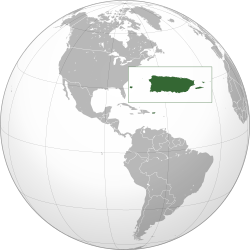Military Government of Porto Rico
Military Government of Porto Rico Gobierno Militar de Puerto Rico (Spanish) | |||||||||
|---|---|---|---|---|---|---|---|---|---|
| 1898–1900 | |||||||||
| Motto: E Pluribus Unum "Out of Many, One" | |||||||||
| Anthem: Salve, Columbia "Hail, Columbia" | |||||||||
 | |||||||||
| Status | United States military occupation (1898–1899) Unincorporated, unorganized territory[a] (1899–1900) | ||||||||
| Capital | San Juan | ||||||||
| Common languages | Spanish, English | ||||||||
| Religion | Roman Catholicism | ||||||||
| Government | Military government | ||||||||
| Military governor | |||||||||
• 1898 | Nelson A. Miles | ||||||||
• 1898 | John R. Brooke | ||||||||
• 1898–1899 | Guy Vernor Henry | ||||||||
• 1899–1900 | George Whitefield Davis | ||||||||
| Historical era | Modern Era | ||||||||
| 10 December 1898 | |||||||||
| 12 April 1900 | |||||||||
| |||||||||
| History of Puerto Rico |
|---|
|
|
The Military Government of Porto Rico (Spanish: Gobierno Militar de Puerto Rico), was a provisional military government in Puerto Rico that was established during the Spanish–American War in 1898.[1]
Timeline
[edit]- 1898
- February 15: The USS Maine explodes in Havana harbor.
- April 20: President McKinley signs a congressional joint resolution declaring war against Spain.
- December 10: Spain and the United States sign the Treaty of Paris.
- 1899
- January 15: The U.S. military government in Puerto Rico changes the name of the island to Porto Rico.
- April 11: The Spanish–American War officially ends.
- 1900
- April 12: President McKinley signs the Foraker Act, establishing civilian government on the island of Porto Rico.
"Americanization" of Puerto Rico
[edit]From 1898 to 1900, Puerto Rico was governed by four military officers: Commanding General Nelson A. Miles, Major General John R. Brooke, Major General Guy Vernon Henry, and Major General George Whitefield Davis. Miles, Brooke, and Henry were experienced veterans of the Indian Wars and, even though they were accustomed to the pacification and administration of the Native Americans, the U.S. Army had no previous experience in the administration of overseas territories.[2] Henry stated: "It was an entirely new duty for American Army officers. There was no precedent in the experience of these so suddenly placed in charge of this our first real colony, upon which their policy could be based."[2]
The administration of Puerto Rico was the responsibility of the United States Department of War's Division of Customs and Insular Affairs, which was modeled after the Bureau of Indian Affairs. Almost immediately, the United States began the "Americanization" process of Puerto Rico. The U.S. occupation brought about a total change in Puerto Rico's economy and polity and did not apply American republicanism to the colony.
In 1899, U.S. Senator George Frisbie Hoar described Puerto Ricans as "uneducated, simple-minded and harmless people who were only interested in wine, women, music and dancing" and recommended that Spanish should be abolished in the island's schools and only English should be taught.[3] Schools became the primary vehicle of Americanization, and initially all classes were taught in English, which also made for a large dropout rate.
On January 15, 1899, the military government changed the name of Puerto Rico to Porto Rico (U.S. Congress would later change the name back to "Puerto Rico" on May 17, 1932) and the island's currency was changed from the Puerto Rican peso to the American dollar, integrating the island's currency into the U.S. monetary system.
See also
[edit]References
[edit]- ^ "Military Government in Puerto Rico".
- ^ a b Strategy as Politics by: Jorge Rodriguez Beruff; Publisher: La Editorial; Universidad de Puerto Rico; page 18–19; ISBN 978-0-8477-0160-5
- ^ Harvey, S.S. (February 22, 1899). "Americanizing Puerto Rico". New York Times. p. 4. Archived from the original on March 4, 2016. Retrieved December 31, 2023.
Notes
[edit]- ^ Puerto Rico belongs to, but is not a part of, the United States. See the page for the Insular Cases for more information.


